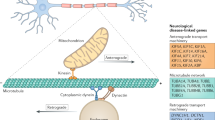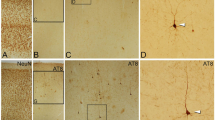Abstract
THE tau gene encodes a protein (Tau) that is a major neuronal microtubule-associated protein localized mostly in axons1–4. It has microtubule-binding and tubulin-polymerizing activity in vitro3,4 and is thought to make short crossbridges between axonal microtubules5,6. Further, tau-transfected non-neuronal cells extend long axon-like processes in which microtubule bundles resembling those in axons are formed6–8. In contrast, tau antisense oligo-nucleotides selectively suppress axonal elongation in cultured neurons9,10. Thus tau is thought to be essential for neuronal cell morphogenesis, especially axonal elongation and maintenance. To test this hypothesis, we used gene targeting to produce mice lacking the tau gene. We show that the nervous system of fan-deficient mice appears to be normal immunohistologically. Furthermore, axonal elongation is not affected in cultured neurons. But in some small-calibre axons, microtubule stability is decreased and microtubule organization is significantly changed. We observed an increase in microtubule-associated protein 1A which may compens-ate for the functions of tau in large-calibre axons. Our results argue against the suggested role of tau in axonal elongation but confirm that it is crucial in the stabilization and organization of axonal microtubules in a certain type of axon.
This is a preview of subscription content, access via your institution
Access options
Subscribe to this journal
Receive 51 print issues and online access
$199.00 per year
only $3.90 per issue
Buy this article
- Purchase on Springer Link
- Instant access to full article PDF
Prices may be subject to local taxes which are calculated during checkout
Similar content being viewed by others
References
Olmsted, J. B. A. Rev. Cell Biol. 2, 421–457 (1986).
Matus, A. A. Rev. Neurosci. 11, 20–44 (1988).
Cleveland, D. W., Hwo, S. Y. & Kirschner, M. W. J. molec. Biol. 116, 207–225 (1977).
Binder, L. I., Frankfurter A. & Rebhun, L. I. J. Cell Biol. 101, 1371–1378 (1985).
Hirokawa, N., Shiomura, Y. & Okabe, S. J. Cell Biol. 107, 1449–1461 (1988).
Chen, J., Kanai, Y., Cowan, N. J. & Hirokawa, N. Nature 360, 674–677 (1992).
Kanai, Y. et al. J. Cell Biol. 109, 1173–1184 (1989).
Knops, J. et al. J. Cell Biol. 114, 725–733 (1991).
Caceres, A. & Kosik, K. S. Nature 343, 461–463 (1990).
Caceres, A., Potrebic, S. & Kosik, K. S. J. Neurosci. 11, 1515–1523 (1991).
Thomas, K. R. & Capecchi, M. R. Cell 51, 503–512 (1987).
Georgieff, I. S., Liem, R. K. H., Mellado, W., Nunez, J. & Shelanski, M. L. J. Cell Sci. 100, 55–60 (1991).
Hirokawa, N. J. Cell Biol. 94, 129–142 (1982).
Dotti, C. G., Sullivan, C. A. & Banker, G. A. J. Neurosci. 8, 1454–1468 (1988).
Goslin, K. & Banker, G. in Culturing Nerve Cells (eds Banker, G. & Goslin, K.) 251–282 (MIT Press, Cambridge, MA, 1991).
Mitchison, T. J. J. Cell Biol 109, 637–652 (1989).
Okabe, S. & Hirokawa, N. J. Cell Biol. 117, 105–120 (1992).
Umeyama, T., Okabe, S., Kanai, Y. & Hirokawa, N. J. Cell Biol. 120, 451–465 (1993).
Sato-Yoshitake, R., Shiomura, Y., Miyasaka, H. & Hirokawa, N. Neuron 3, 229–238 (1989).
Shiomura, Y. & Hirokawa, N. J. Neurosci. 7, 1461–1469 (1987).
Bloom, G. S., Schoenfeld, T. A. & Vallee, R. B. J. Cell Biol. 98, 320–330 (1985).
Lee, K. et al. Cell 69, 737–749 (1992).
Himmler, A. Molec. cell. Biol. 9, 1389–1396 (1989).
Lee, G. Cell Motil. Cytoskel. 15, 199–203 (1990).
McBurney, M. W. et al. Nucleic Acids Res. 19, 5755–5761 (1991).
Li, E., Bestor, T. H. & Jaenisch, R., Cell 69, 915–926 (1992).
Bradley, A. in Teratomas and Embryonic Stem Cells: A Practical Approach (ed Robertson, E. J.) 113–152 (IRL, Oxford, 1987).
Harada, A., Sobue, K. & Hirokawa, N. Cell Struct. Funct. 15, 329–342 (1990).
Ihara, Y. et al. Gerontology 36, 15–24 (1990).
Hondo, J. et al. Neuron 1, 827–834 (1988).
Author information
Authors and Affiliations
Rights and permissions
About this article
Cite this article
Harada, A., Oguchi, K., Okabe, S. et al. Altered microtubule organization in small-calibre axons of mice lacking tau protein. Nature 369, 488–491 (1994). https://doi.org/10.1038/369488a0
Received:
Accepted:
Issue Date:
DOI: https://doi.org/10.1038/369488a0
This article is cited by
-
Complexes of tubulin oligomers and tau form a viscoelastic intervening network cross-bridging microtubules into bundles
Nature Communications (2024)
-
Hyperphosphorylated Tau Inflicts Intracellular Stress Responses that Are Mitigated by Apomorphine
Molecular Neurobiology (2024)
-
Tau suppresses microtubule-regulated pancreatic insulin secretion
Molecular Psychiatry (2023)
-
The evolution of microtubule associated proteins – a reference proteomic perspective
BMC Genomics (2022)
-
Caspase-cleaved tau is senescence-associated and induces a toxic gain of function by putting a brake on axonal transport
Molecular Psychiatry (2022)
Comments
By submitting a comment you agree to abide by our Terms and Community Guidelines. If you find something abusive or that does not comply with our terms or guidelines please flag it as inappropriate.



